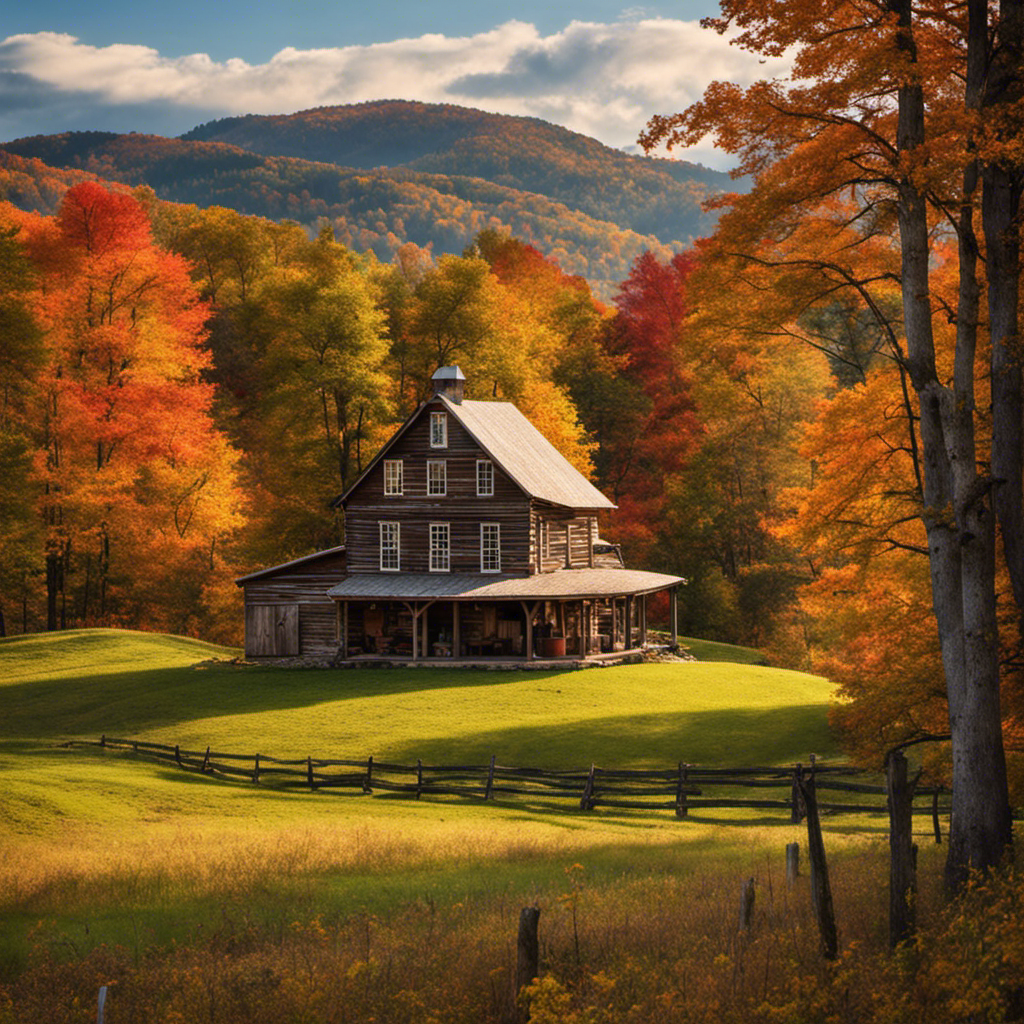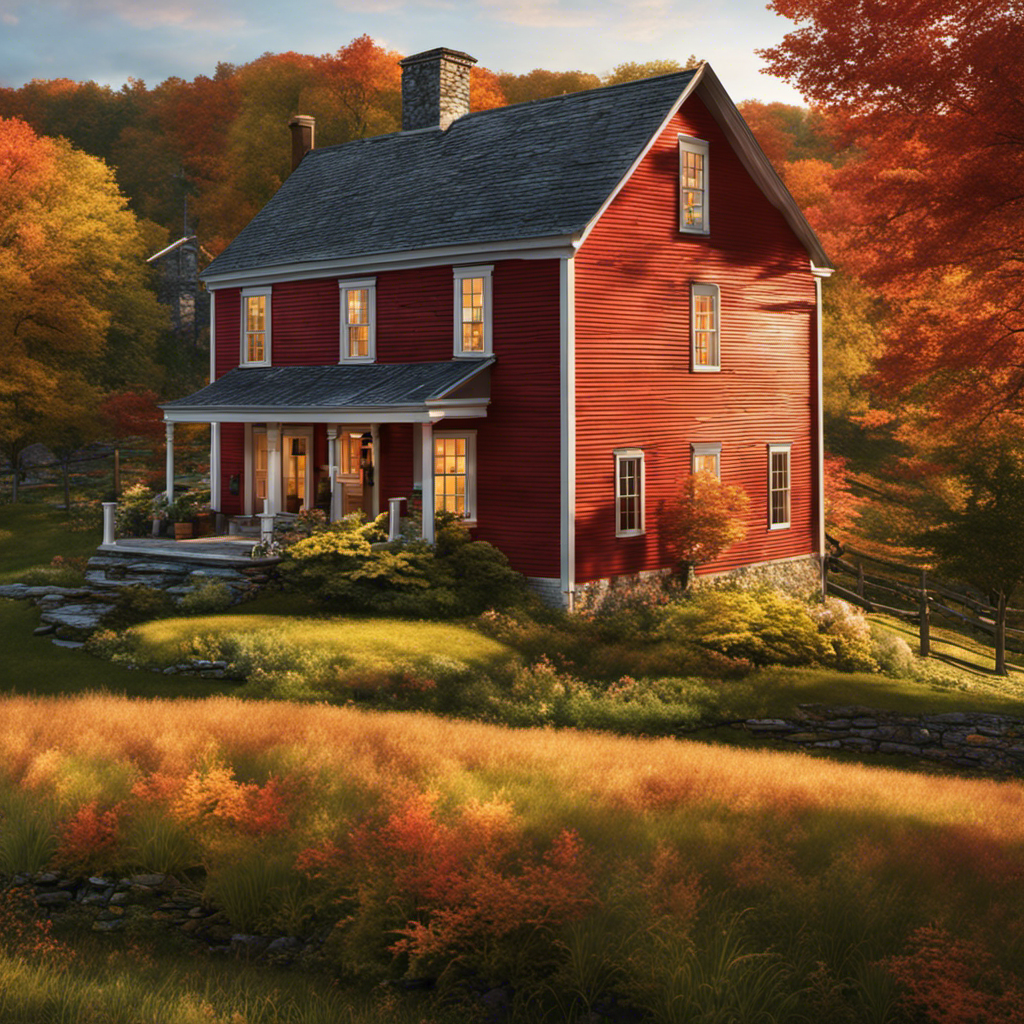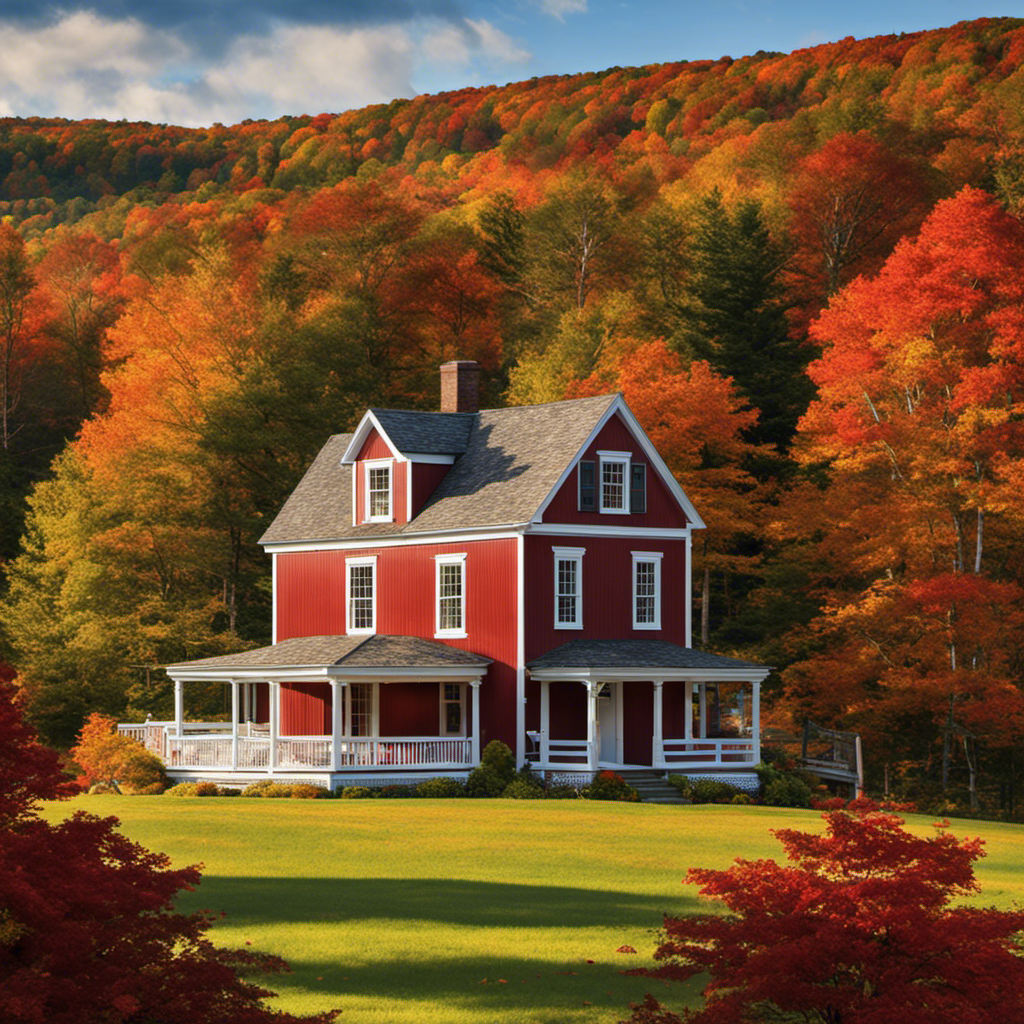Take a journey back in time and delve into the fascinating history of New England by touring the top ten most iconic historic farmhouses.
From the charming Sturbridge Farmhouse in Massachusetts to the picturesque Hildene Farmhouse in Vermont, each one tells a fascinating story of the region’s agrarian past.
Get ready to step through the doors of these beautifully preserved homes, where you’ll discover a world of bygone days and experience the liberation of connecting with the past.
Key Takeaways
- Sturbridge Farmhouse and Hildene Farmhouse offer immersive experiences to appreciate craftsmanship and heritage.
- Buttolph-Williams Farmhouse, Rundlet-May Farmhouse, and Watson Farmhouse have rich history and architectural significance with meticulous restoration efforts.
- Hildene Farmhouse and Watson Farmhouse showcase well-preserved architectural features and design, highlighting the beauty of New England farmhouses.
- Hildene Farmhouse and Watson Farmhouse provide insights into traditional farming techniques and sustainable agriculture practices.
The Sturbridge Farmhouse in Massachusetts
You should visit the Sturbridge Farmhouse in Massachusetts, where you can step back in time and experience the rich history of this charming New England farmhouse.
The Sturbridge Farmhouse, built in the late 18th century, has undergone several renovation challenges in order to preserve its historical authenticity. The restoration process was carefully carried out to maintain the farmhouse’s original architectural features and unique character.
As you explore the farmhouse, you’ll come across a fascinating collection of historical artifacts that give insight into the lives of the people who once lived there. From antique furniture to handmade tools, these artifacts provide a glimpse into the daily life and cultural significance of the farmhouse.
It’s a truly immersive experience that allows you to appreciate the craftsmanship and heritage of this remarkable place.
The Hildene Farmhouse in Vermont
As you approach the Hildene Farmhouse in Vermont, you’ll be immediately struck by its impressive architectural features and the meticulous preservation of its historical charm.
This farmhouse holds a significant place in Vermont’s history, serving as the former home of Robert Todd Lincoln, the son of President Abraham Lincoln.
Step inside and you’ll be transported back in time, as you learn about the farming practices and traditions that shaped the region’s agricultural heritage.
Architectural Features and Preservation
Take a stroll through the Hildene Farmhouse in Vermont and marvel at its well-preserved architectural features.
This historic farmhouse, with its rich history and architectural significance, offers a glimpse into the past. The farmhouse, built in the 19th century, showcases the beauty of New England farmhouses with its intricate woodwork and charming details. Its architectural preservation is a testament to its historical significance as it stands as a reminder of the region’s agricultural heritage.
The farmhouse features a two-column and five-row table that further enhances its historical significance. This table displays information about the farmhouse’s original owners, construction materials used, and notable architectural elements. It serves as a visual representation of the farmhouse’s story, allowing visitors to appreciate its historical and architectural importance.
Take a moment to explore this exquisite farmhouse and immerse yourself in its rich history.
Historical Significance and Stories
Explore the Hildene Farmhouse in Vermont and discover the fascinating stories behind its historical significance. Step into a world where the past comes alive, as you delve into the rich history of this iconic farmhouse.
The Hildene Farmhouse stands as a testament to the historical preservation efforts that have been made to protect and honor our cultural heritage. This remarkable structure not only showcases the architectural features of its time but also holds a deep cultural impact and legacy.
As you wander through its rooms, you’ll uncover the stories of the families who lived here, their struggles, and their triumphs. From the antique furniture to the preserved artifacts, every corner of the Hildene Farmhouse whispers tales of a bygone era.
Immerse yourself in the history and let its stories liberate your imagination.
Farming Practices and Traditions
You can learn about the unique farming practices and traditions of the Hildene Farmhouse in Vermont. Located in the picturesque town of Manchester, this historic farmhouse offers a glimpse into the region’s rich agricultural heritage. The Hildene Farmhouse is a living museum that showcases traditional farming techniques and celebrates the importance of sustainable agriculture.
Here are some highlights of what you can discover at Hildene:
-
Crop Rotation: Learn about the practice of rotating crops to maintain soil fertility and prevent pests and diseases.
-
Livestock Management: Explore the methods used to raise and care for animals, including dairy cows, sheep, and chickens.
-
Heirloom Varieties: Discover the beauty and diversity of heirloom fruits and vegetables, and understand their significance in preserving agricultural heritage.
-
Seasonal Harvesting: Experience the rhythm of the farming calendar as you learn about the different crops harvested throughout the year.
At Hildene Farmhouse, you’ll gain a deeper understanding of the timeless farming techniques and traditions that have shaped the agricultural landscape of Vermont.
The Coggeshall Farmhouse in Rhode Island
When you visit the Coggeshall Farmhouse in Rhode Island, you’ll be transported back to the 18th century.
This historic farmhouse holds significant cultural and historical value, showcasing the agricultural heritage of the region.
The farmhouse has undergone extensive restoration efforts to preserve its original charm and provide visitors with an authentic experience of life on a working farm in colonial America.
Historical Significance of Coggeshall
Have you ever visited the Coggeshall Farmhouse and experienced its historical significance? If not, you’re missing out on a truly enriching experience. Here’s why you should consider exploring the historical significance of Coggeshall:
-
Coggeshall’s impact on the local community: The farmhouse has deep roots in the local community, serving as a gathering place for generations and offering a unique glimpse into the past. It has played a vital role in preserving the history and heritage of the area.
-
Coggeshall’s historical artifacts and documents: The farmhouse is home to a remarkable collection of artifacts and documents that provide valuable insights into the lives of the people who lived and worked there. From tools and furniture to handwritten letters and diaries, each item tells a story and adds to the historical significance of Coggeshall.
Visiting Coggeshall Farmhouse allows you to connect with the past and appreciate the historical importance of this remarkable place. Don’t miss out on this opportunity to step back in time and learn about the rich history of the local community.
Farmhouse Restoration Efforts
Take a tour of the Coggeshall Farmhouse to see the impressive results of the ongoing restoration efforts.
The preservation challenges faced by this historic farmhouse are numerous, but through the dedication and commitment of the community, significant progress has been made.
The farmhouse, originally built in the 17th century, had suffered from years of neglect and decay. However, with community involvement and support, restoration efforts have brought this piece of history back to life.
The challenges included structural damage, rotting wood, and outdated electrical systems. But with the help of volunteers and skilled craftsmen, the farmhouse has been lovingly restored to its former glory.
The community’s involvement in this restoration project demonstrates their deep appreciation for history and their desire to preserve it for future generations to enjoy.
The Buttolph-Williams Farmhouse in Connecticut
You should visit the Buttolph-Williams Farmhouse, one of the ten most historic New England farmhouses to explore. This farmhouse in Connecticut holds a rich history and architectural significance that will transport you back in time. The restoration efforts of the Buttolph-Williams Farmhouse have been meticulous, ensuring that its original charm and authenticity are preserved.
Here are some key features that make this farmhouse a must-visit:
-
Colonial architecture: The farmhouse showcases the classic New England colonial style, with its symmetrical design and steeply-pitched roofs.
-
Wide-plank floors: Walk on the same wide-plank floors that have endured for centuries, giving the farmhouse a rustic and authentic feel.
-
Exposed beams: Marvel at the beauty of the exposed wooden beams, a testament to the craftsmanship of the time.
-
Period furnishings: Immerse yourself in the past with the farmhouse’s period furnishings, carefully chosen to reflect the historical era.
Visiting the Buttolph-Williams Farmhouse is like stepping into a time capsule, allowing you to experience the history and charm of an authentic New England farmhouse.
The Rundlet-May Farmhouse in New Hampshire
When was the Rundlet-May Farmhouse built, and is it open to the public for tours?
The Rundlet-May Farmhouse, a historic gem nestled in New Hampshire, was constructed in 1807. This exquisitely preserved farmhouse offers visitors a unique opportunity to step back in time and immerse themselves in the rich farming traditions of the early 19th century.
The farmhouse, listed on the National Register of Historic Places, showcases the architectural beauty and functional design of that era. As you explore the property, you’ll be transported to a time when farming was the backbone of the community, and every aspect of life revolved around the land.
The Rundlet-May Farmhouse stands as a testament to the perseverance and dedication of those who tirelessly worked to preserve this piece of history. Today, it’s open to the public for tours, providing a captivating glimpse into the past and allowing visitors to appreciate the farmhouse preservation efforts that have ensured its longevity.
The Watson Farmhouse in Rhode Island
When you visit the Watson Farmhouse in Rhode Island, you’ll be transported back in time to experience its rich historical significance.
The farmhouse, dating back to the 18th century, showcases architectural features and design that are emblematic of the time period.
As you explore the property, you’ll gain insight into the farming practices and lifestyle of the past, giving you a deeper understanding of the region’s agricultural history.
Historical Significance of Watson Farmhouse
Take a tour and discover the rich history behind the Watson Farmhouse, a true gem in Rhode Island. This historic farmhouse holds immense historical significance and has been meticulously preserved over the years. Its historical context and the preservation efforts that have gone into maintaining its authenticity make it a must-visit destination for history enthusiasts.
Step inside and explore the original 18th-century furniture and decor that transport you back in time.
Learn about the farm’s agricultural practices and how they’ve evolved over the years.
Discover the stories of the Watson family and their contributions to the local community.
Uncover the architectural evolution of the farmhouse, from its humble beginnings to its current state of grandeur.
The Watson Farmhouse offers a captivating glimpse into the past, allowing you to appreciate the architectural features and design that have stood the test of time.
Architectural Features and Design
You’ll be amazed by the intricate craftsmanship and attention to detail that went into creating the architectural features and design of the Watson Farmhouse.
This historic farmhouse showcases a blend of architectural styles that reflect the evolution of New England’s rural architecture over the centuries. The farmhouse boasts a classic Georgian structure with symmetrical windows and a central chimney, which is characteristic of the 18th-century period.
The preservation techniques employed have ensured that the original wooden clapboard siding, wide-plank floors, and hand-carved moldings have been impeccably maintained.
The interior of the farmhouse is a testament to its rich history, with each room showcasing a unique architectural feature, such as the ornate fireplaces, built-in cabinetry, and decorative trim.
The Watson Farmhouse truly stands as a remarkable example of architectural excellence, preserving the beauty and charm of New England’s farming heritage.
Farming Practices and Lifestyle
Explore the traditional farming practices and lifestyle that were integral to the history of the Watson Farmhouse. Step into the shoes of the farmers who worked the land and discover the rich heritage of their agricultural innovations.
-
Sustainable farming: The Watson Farmhouse embraced sustainable farming techniques, utilizing crop rotation and natural fertilizers to maintain soil fertility.
-
Livestock management: Cattle, sheep, and pigs roamed the fields, providing milk, meat, and wool for the farm’s sustenance and trade.
-
Harvesting techniques: Witness the meticulous hand harvesting of crops like wheat, corn, and vegetables, ensuring nothing went to waste.
-
Preservation methods: Experience the art of canning, drying, and smoking, which allowed the farmers to store food for the long New England winters.
Immerse yourself in this authentic farming experience at the Watson Farmhouse, and as you continue your journey, discover the fascinating history of the Moffatt-Ladd Farmhouse in New Hampshire.
The Moffatt-Ladd Farmhouse in New Hampshire
Step inside the Moffatt-Ladd Farmhouse and experience the rich history of New Hampshire. This historic farmhouse, located in Portsmouth, has been meticulously restored to its original glory, offering visitors a glimpse into the past. The Moffatt-Ladd Farmhouse holds great historical significance, as it was once the residence of prominent figures in American history, including William Whipple, a signer of the Declaration of Independence.
The farmhouse restoration project aimed to preserve the architectural integrity of the building while showcasing the historical artifacts and stories that make it so unique. A tour of the Moffatt-Ladd Farmhouse takes you on a journey through time, with each room telling a different tale of the past. From the grand parlor, where guests were entertained, to the kitchen, where meals were prepared, every corner of this farmhouse holds a piece of history.
To fully appreciate the historical significance of the Moffatt-Ladd Farmhouse, let’s take a closer look at some key details:
| Feature | Description |
|---|---|
| Architecture | Georgian-style mansion with elegant detailing and symmetry |
| Gardens | Well-manicured grounds showcasing period-appropriate landscaping |
| Artifacts | Antique furniture, artwork, and personal belongings of the Moffatt-Ladd family |
| Historical Events | Meeting place for influential figures during the American Revolution |
| Preservation Efforts | Ongoing restoration and maintenance to ensure its longevity |
Visiting the Moffatt-Ladd Farmhouse is not just an opportunity to learn about New Hampshire’s history, but also to connect with the past and appreciate the efforts put into preserving our heritage. So, step inside and immerse yourself in the rich tapestry of the Moffatt-Ladd Farmhouse. Liberation awaits as you explore the stories that have shaped our nation.
The Spencer-Peirce-Little Farmhouse in Massachusetts
As you stroll through the Spencer-Peirce-Little Farmhouse in Massachusetts, you’ll be transported to a bygone era of colonial America. This historic farmhouse holds immense historical significance and has been meticulously preserved to offer visitors a glimpse into the past. Here are four reasons why exploring this farmhouse is a must for anyone interested in history and farming traditions:
-
Immerse yourself in history: The Spencer-Peirce-Little Farmhouse dates back to the 17th century and has witnessed centuries of American history. From its stunning architecture to the artifacts on display, every corner tells a story.
-
Preservation at its finest: The farmhouse has been carefully maintained to preserve its original charm. Step inside and experience the authentic ambiance of colonial living.
-
Discover farming practices: Explore the barns and outbuildings to learn about traditional farming techniques. From cultivating crops to tending to livestock, the farmhouse offers a unique insight into the challenges and innovations of early American farming.
-
Engage with the past: Participate in hands-on activities and demonstrations that bring the farming traditions of colonial Massachusetts to life. Get your hands dirty and experience firsthand what life was like for the early settlers.
Visiting the Spencer-Peirce-Little Farmhouse is an opportunity to reconnect with history, appreciate the beauty of preservation, and gain a deeper understanding of the farming practices that shaped our nation. So, come and embark on a journey through time at this remarkable historic site.
The Smith-Appleby Farmhouse in Rhode Island
Don’t miss out on the fascinating history and well-preserved charm of the Smith-Appleby Farmhouse in Rhode Island, as it offers a unique glimpse into the region’s farming traditions. This historic farmhouse, built in 1696, has undergone extensive restoration efforts to maintain its authenticity and showcase its rich heritage. The Smith-Appleby Farmhouse is a true gem that transports you back in time to the early days of farming in Rhode Island.
Here’s a glimpse at some of the farming practices that were prevalent during that era:
| Farming Practices | Description |
|---|---|
| Crop Rotation | The farmers at Smith-Appleby practiced crop rotation to maintain soil fertility and minimize pests and diseases. This practice involved growing different crops in a systematic order, allowing the soil to replenish its nutrients naturally. |
| Animal Husbandry | Livestock played a crucial role in the daily life of the farmhouse. Farmers raised animals such as cows, pigs, and chickens for milk, meat, and eggs. They also used horses for plowing the fields and transportation purposes. |
| Sustainable Farming | The farmers at Smith-Appleby followed sustainable farming practices, such as composting and using natural fertilizers, to minimize the use of chemical inputs and protect the environment. |
Visiting the Smith-Appleby Farmhouse is not only a chance to witness the restoration efforts that have preserved its charm, but also an opportunity to learn about the farming practices that shaped Rhode Island’s agricultural history. So, come and immerse yourself in this captivating journey back in time.
The Remick Country Doctor Museum & Farmhouse in New Hampshire
Have you ever visited the Remick Country Doctor Museum & Farmhouse in New Hampshire, and if so, what’s your favorite part of the experience?
This historic farmhouse offers a unique glimpse into the farming traditions and medical history of the region. Here are four reasons why you should explore this fascinating museum:
-
Step into the past: As you walk through the farmhouse, you’ll be transported back in time to the 1800s. Experience the daily life of a country doctor and learn about the challenges they faced.
-
Hands-on activities: Engage in interactive exhibits and activities that allow you to immerse yourself in the history. Try your hand at traditional farming techniques or learn about herbal remedies used in the past.
-
Educational programs: The museum offers a range of educational programs for all ages. From workshops on sustainable farming to talks on medical advancements, there’s something for everyone to learn and enjoy.
-
Beautiful surroundings: Set in the picturesque countryside, the Remick Farmhouse provides a serene and peaceful environment to explore. Take a leisurely stroll through the gardens or enjoy a picnic on the grounds.
Frequently Asked Questions
What Is the Admission Fee for Visiting These Historic New England Farmhouses?
Admission fees for these historic New England farmhouses vary, depending on the specific farmhouse and the type of experience you’re looking for. Some farmhouses offer guided tours, which may have an additional fee. It’s best to check the website or contact the farmhouse directly for the most up-to-date information on admission prices and tour options.
Exploring these farmhouses will give you a chance to step back in time and immerse yourself in the rich history of New England.
Are Guided Tours Available at These Farmhouses?
Yes, guided tours are available at these historic New England farmhouses. You’ll have the opportunity to explore the rich historical significance of each farmhouse in a thorough and detailed manner.
Knowledgeable guides will lead you through the different areas, providing fascinating insights into the lives of the people who once lived there.
This immersive experience allows you to truly step back in time and gain a deep appreciation for the history of these farmhouses.
Can Visitors Interact With Animals at These Farmhouses?
Visitors interacting with animals is a delightful experience at these farmhouses. Animal encounters are an integral part of the immersive environment created for visitors.
You’ll have the opportunity to get up close and personal with a variety of farm animals, from friendly goats to curious chickens. Whether you’re petting a fluffy bunny or feeding the horses, these farmhouses provide a unique and hands-on experience that will make your visit unforgettable.
Are There Picnic Areas or Food Options Available On-Site?
Looking for a place to enjoy a picnic? You’ll be pleased to know that many of these historic New England farmhouses have beautiful picnic spots where you can relax and enjoy the scenery.
And if you’re hungry, some even offer local cuisine options on-site, so you can indulge in delicious farm-to-table meals.
Are These Farmhouses Wheelchair Accessible?
Yes, these farmhouses are wheelchair accessible, allowing everyone to experience their historical significance. The owners have made sure to provide ramps and wide doorways for easy access.
Inside, you’ll find spacious rooms that are designed to accommodate wheelchairs. Whether you’re exploring the living quarters or the barns, you’ll be able to navigate freely.
It’s wonderful to see these historic sites embracing inclusivity and ensuring that everyone can enjoy their rich history.
Are the Top 10 New England Farmhouses Every History Buff Must Visit the Same as the Top 10 Historic New England Farmhouses to Explore?
Are the Top 10 New England Farmhouses Every History Buff Must Visit the Same as the Top 10 Historic New England Farmhouses to Explore? While both categories focus on new england farmhouse history buffs, the key difference lies in their perspective. The Top 10 New England Farmhouses Every History Buff Must Visit emphasizes must-see locations, highlighting sites that are highly recommended for enthusiasts. On the other hand, the Top 10 Historic New England Farmhouses to Explore encompasses a broader range of farmhouses that offer historical value, giving visitors a chance to delve into the region’s rich heritage.
Are These Historical Farmhouses Open for Tours?
Are these top northeast historical farmhouses open for tours? Step back in time as you explore these beautifully preserved pieces of history. Immerse yourself in the rustic charm and architectural wonders of these farmhouses, all while learning about the region’s rich historical significance. From New Hampshire to Maine, discover the stories behind these remarkable structures and experience a glimpse into the past. Plan your visit today and get ready to be transported to a bygone era.
Conclusion
In conclusion, exploring these historic New England farmhouses is like taking a step back in time. Each farmhouse offers a unique glimpse into the region’s rich history. Whether you’re interested in colonial architecture, agricultural traditions, or simply want to immerse yourself in the past, these farmhouses are sure to transport you to a bygone era.
From the Sturbridge Farmhouse in Massachusetts to the Remick Country Doctor Museum & Farmhouse in New Hampshire, there are plenty of options to choose from. These farmhouses are a testament to New England’s fascinating agricultural heritage.
So grab your walking shoes and embark on a journey through New England’s fascinating agricultural heritage.











